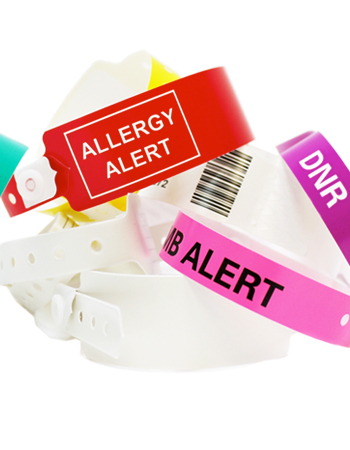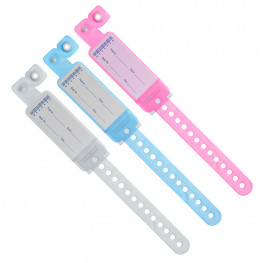Exactly How a Patient Identification Band Can Boost Medical Facility Performance and Accuracy
Patient Identification Bands: A Secret Tool for Improved Medical Accuracy
Person recognition bands represent a critical element in the pursuit of clinical accuracy and individual security within medical care atmospheres. The real extent of their influence on person outcomes and total medical care high quality warrants better evaluation.

Relevance of Person Recognition
Patient identification is an important part of health care that makes sure the safety and accuracy of clinical therapy. Correct recognition procedures are necessary to stop medical errors, which can cause adverse person results, including wrong medication management, misdiagnosis, or improper treatment plans. The value of precise client recognition can not be overemphasized, as it serves as the structure for efficient communication amongst doctor.
In environments where several clients are obtaining treatment all at once, the threat of identification confusion rises. Carrying out durable identification systems helps alleviate these risks and improves patient security. Patient Identification Band. Precise recognition adds to the honesty of medical documents, making certain that client backgrounds, allergic reactions, and previous treatments are properly connected to the appropriate individual.
Furthermore, conformity with governing standards and accreditation demands frequently mandates rigid person identification methods, fostering a culture of liability and top quality treatment. Ultimately, the significance of individual recognition goes beyond mere administrative jobs; it is a basic element of providing high-grade healthcare that prioritizes individual safety and security and boosts clinical outcomes. Purchasing effective identification methods is not just useful-- it's imperative in today's complex healthcare landscape.
Types of Patient Identification Bands
In healthcare settings, various sorts of person recognition bands are used to make certain exact recognition and improve safety. These bands function as a crucial device in protecting against clinical errors connected to patient misidentification.
One of the most typical type is the basic wristband, usually made of durable plastic and published with the individual's name, date of birth, and an unique recognition number. These wristbands are usually color-coded to communicate particular details, such as allergic reactions or other clinical conditions.
Another kind is the barcode wristband, which integrates a scannable barcode connected to the individual's electronic wellness record. This technology enables efficient data access and verification throughout medication management and other professional processes.
Additionally, RFID (Superhigh Frequency Identification) bands are coming to be increasingly preferred. These bands can communicate wirelessly with hospital systems, enabling real-time monitoring and recognition of people, thus improving and simplifying workflows individual safety.

Advantages for Doctor
Using client identification bands supplies significant advantages for doctor, improving both operational efficiency and person security. These bands function as a crucial device in improving patient monitoring processes (Patient Identification Band). By ensuring exact identification, doctor can minimize the risk of management errors, such as mislabeling examples or misdirecting treatments, which can cause costly hold-ups and problems
In addition, client identification bands promote seamless interaction among the health care group. With easily accessible and standardized person information, companies can make informed decisions promptly, improving general operations. This effectiveness is specifically vital in high-pressure atmospheres such as emergency situation departments, where time-sensitive interventions are important.
The implementation of identification bands likewise sustains conformity with regulatory requirements and ideal practices, thus lessening the threat of legal repercussions stemming from recognition mistakes. The usage of these bands boosts data accuracy in electronic health records, leading to better care coordination and continuity.
Effect on Individual Safety And Security
Exact person get redirected here recognition is a keystone of health care safety, dramatically minimizing the likelihood of mistakes that can jeopardize individual wellness. Making use of individual identification bands is vital in making certain that each person obtains the right therapy, medicines, and procedures. These bands serve as a reliable reference factor for medical care experts, lessening the danger of misidentification, which can result in major consequences such as incorrect drug management or medical errors.
The implementation of standard individual recognition bands contributes to a culture of safety and security within medical care setups. By supplying clear, easily readable details, these bands aid to strengthen the value of confirming client identification at every stage of care. In addition, they assist in communication amongst personnel, making sure that everybody entailed in an individual's care knows their particular demands and demands.
On top of that, making use of client recognition bands can enhance the accuracy of digital health documents, further decreasing the possibility for errors - Patient Identification Band. By prioritizing person security via efficient recognition methods, healthcare companies can cultivate trust and confidence among people, eventually leading to far better clinical end results and boosted patient satisfaction. The impact of visit homepage appropriate person recognition can not be overstated; it is a fundamental aspect of high-grade healthcare delivery
Best Practices for Application
Effective execution of client identification bands is critical for boosting client safety and security and lessening errors in medical care settings. Staff training is crucial; all team participants need to understand the relevance of precise patient recognition and the procedures for band application.
2nd, the layout of the recognition bands ought to focus on exposure and resilience. Bands have to be simple to review, consist of necessary client info, and withstand day-to-day wear. Using color-coding can further boost quick recognition.


Third, integrating digital wellness documents (EHR) with identification band systems can improve workflow. Automated signals for disparities in client recognition can stop potential mistakes prior to they happen.
Lastly, carrying out regular audits and comments sessions will certainly assist identify areas great site for improvement. Involving staff in these discussions promotes a society of security and liability.
Conclusion
In conclusion, client identification bands play a vital duty in boosting medical precision and ensuring patient safety within healthcare systems. Adopting best practices for implementation fosters a society of safety and security, inevitably leading to boosted person end results and better depend on in health care services.
Client identification bands represent a critical part in the search of clinical accuracy and client safety within healthcare settings.Making use of individual identification bands offers substantial benefits for health care companies, enhancing both operational performance and individual safety and security. By prioritizing client safety and security with effective recognition methods, healthcare companies can foster trust and self-confidence among patients, inevitably leading to much better clinical end results and enhanced patient satisfaction.Reliable implementation of person identification bands is critical for improving patient security and minimizing mistakes in healthcare setups.In conclusion, person identification bands play a crucial function in boosting medical precision and guaranteeing individual safety within health care systems.